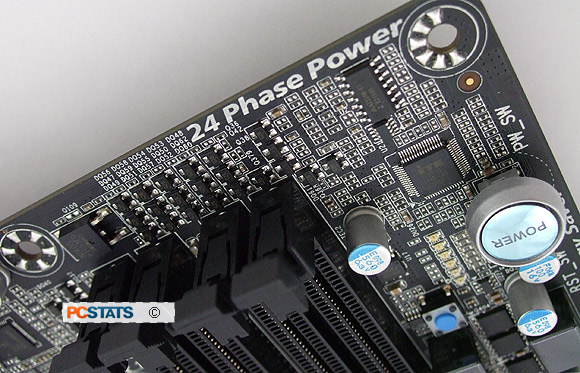 |
| Overclocking Results: |
|
|
Owing to
the greater number of things integrated onto the die of Intel's 'Sandybridge'
Core i5 processors, these LGA1155 CPUs really don't react well to overclocking
via motherboard BCLK adjustments. Hard core overclockers HAVE done it, but it's far more
effort than it's worth in our opinion.
Overclocking is supposed to be fun, overclocking by Bclk is
not fun.
Gigabyte's GA-P67A-UD7-B3 motherboard offers a full
range of CPU overclocking controls so PCSTATS only made a half hearted attempt
to push the board past a 105MHz BCLK. We
tried, but no luck.
Starting off with a default x33 multiplier, PCSTATS
pushed the Intel Core i5 2500K CPU to x46 without any effort. Usually the Intel
Core i5 2500K chip PCSTATS tests with can handle x47 out of the gate without any
voltage tweaking. As we've seen with a couple other Intel P67 based motherboards
the Gigabyte GA-P67A-UD7-B3 motherboard managed to hit a maximum overclock
of x46, or 4.6GHz.
In case something goes awry during overclocking, the
onboard Port 80 card helpfully displays an error code. In addition to the Port80
card, Gigabyte have built in custom overclocking controls such as Easy Tune 6
which allows novice overclockers to adjust BCLK, CPU multiplier, voltages, etc.
from within Windows. Overclocking profiles can bet set up and initialized with
the tap of a key for certain applications.
Cloud Computing for
Overclockers
CloudOC is another neat Gigabyte overclocking tool which
allows you to manage the overclocking profiles of your computer from a networked
device (ie iPhone, iPad), but I have to admit I'm not a fan of such techniques.
Never the less, if you've ever wanted to manage overclock settings during a
benchmark run, or while in full screen game mode you can now overclock your PC
via an iPad app.
Other overclocking revisions with the board include
finer voltage controls (down to 0.00625V increments), hardware over voltage
control, hardware and linear real time voltage control.
Removing the custom heatpipe heatsink for the CPU VRM
reveals the special 3-in-1 board mounted MOSFETs that Gigabyte selected for a
variety of power quality, space conservation and temperature reasons. The system
comes from the Gigabyte X58A-UD9 board originally, it delivers 24-phases of
power to the Sandy Bridge processor. This can translate into more stable power
during intense overclocking situations.

According to Gigabyte, while 24-phases are not really
necessary at all, though it does help spread the electrical load and that
dissipates heat buildup between the devices. This in turn decreases operating
temperatures.
The 3-in-1 driver MOSFET combines the functions of a
SOP-8 driver, LFPAK H-side MOS and LFPak L-side MOS into one compact board
mounted IC package. According to Gigabyte PR reps, the benefits of this are
lower power loss, higher power efficiency and reduced CPU VRM temperatures.
Gigabyte claims that this component choice is more efficient with higher
switching frequencies than previous circuit designs.
The Gigabyte GA-P67A-UD7-B3 motherboard is also Intel
VRD12 qualified.
Under normal power loading, about half of the 24 power
phases are active on the GA-P67A-UD7-B3 motherboard. The system will
automatically shift to the full compliment of 24 phases under heavy loading
situations to ensure the processor received consistent quality power, provided
Gigabyte DES2 is active on the host PC.
